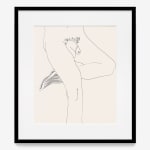-
Artworks
Andy Warhol
Male Nude Sitting, 1956Black ballpoint pen on Manila paper16 3/4 x 13 7/8 in (42.5 x 35.2 cm)© 2025 Andy Warhol Foundation for the Visual Arts / Artists Rights Society (ARS), New York. Courtesy of Zeit Contemporary Art, New YorkFurther images
The drawing 'Male Nude Sitting' by Andy Warhol, completed in 1956, represents a pivotal moment in the artist’s early career, marking a period of intimate exploration and the honing of...The drawing 'Male Nude Sitting' by Andy Warhol, completed in 1956, represents a pivotal moment in the artist’s early career, marking a period of intimate exploration and the honing of his artistic voice. Crafted with the simple yet confident line of a ball-point pen on Manila paper, this piece is part of a larger body of drawings from the 1950s that Warhol, at the time, kept akin to a private diary. It wasn't until the exhibition "Success Is a Job in New York: The Early Art and Business of Andy Warhol,” curated by Donna de Salvo in 1989, that these deeply personal works were introduced to the broader public. This revealed an undercurrent of Warhol’s early artistic journey that, until then, had remained largely unseen, allowing a recontextualization of his more renowned later works within this foundational creative period.
In 'Male Nude Sitting,' the subject is rendered with an economy of line that speaks volumes about Warhol's ability to convey complex human emotions—such as love, sex, and desire—through seemingly simple artistic choices. The clarity of the line mirrors the artist’s attempt to crystallize his thoughts on subjects that were deeply personal. The inclusion of a heart on the tip of the subject's penis can be seen as Warhol’s playful yet poignant attempt to merge the physicality of sex with the emotionality of love, perhaps reflecting his own internal musings on these themes. The drawing's unembellished style offers an unguarded look into Warhol's personal reflections on human vulnerability and sensuality.
The visual language of this drawing is as frank as it is unassuming. Warhol’s deliberate use of negative space and unadorned composition allows the viewer to focus on the contours and posture of the figure, which are imbued with a sense of ease and naturalism. There's a stark honesty to the way Warhol presents his subject, devoid of background distractions, emphasizing the raw and unrefined nature of human form and sexuality. This drawing, like many from this period, laid the groundwork for Warhol’s later preoccupations with the surface and the society of the spectacle, hinting at the duality of exposure and concealment that would become a recurring theme throughout his oeuvre. It is a testament to Warhol's enduring interest in the complexities of identity and the performative aspects of daily life, insights that he would continue to develop throughout his illustrious career.
NOTES
This artwork is stamped by The Andy Warhol Foundation for the Visual Arts and The Estate of Andy Warhol, inscribed with the initials V.F. (Vincent Fremont) and numbered '205.025' in pencil on the verso.
Provenance
The artist's estate
The Andy Warhol Foundation for the Visual Arts, New York
Private collection, United States
Publications
Alan Cumming. Andy Warhol: Men, San Francisco, Chronicle Books in association with the Andy Warhol Foundation for Visual Arts, 2004, illustrated in color (unpaged).
Michael Dayton Hermann (editor). Andy Warhol. Love, Sex & Desire. Drawings 1950-1962. New York, Taschen, 2020, illustrated in color on page 110.






